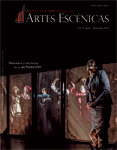Authors
Abstract
The objective of studying Ester Goris’ performance in the film Eva Perón is, on one hand, to go deeper on Evita’s mythical figure and understand, on the other hand, the acting dynamics in order to formulate a historical character of such features. The research incorporates in its analysis concepts previously postulated by historians and scholars on the literary field who determined three mythical variables about Eva Perón: holy Eva, activist Eva and the woman with the whip. From these theories, the figure is observed in order to understand how these variants also explain the creative process. The intention is to think the voice, the movements and the body composition of this acting performance. From this aspect, Foucault’s (2002) article “Docile Bodies” was used by Esther Goris for the construction of Evita’s body who acquires a transgressive corporeality at preestablished rythms and questions the feminine and masculine aspects accepted at the time. At this point, the struggle from Anette Khun (1991) and Laura Mulvey’s (2007) theory is defined. In short, it can be observed how Goris creation promotes an androgynous and disruptive profile of the time narrated in the film content but, at the same time, it can be confirmed that such transgresion is not totally applied in the story as it is constructed in a classic mode.
Keywords
References
Desanzo, J.C. (director). (1996). Eva Perón, el mito [Cinta cinematográfica].
Foucault, M. (2002). Cuerpos dóciles. En Foucault, M., Vigilar y castigar, Argentina:Siglo XXI.
Jones, A.R. (2001). Escribiendo el cuerpo.En Navarro, M. & Stimpson, C.R. (Comps.),Nuevas Direcciones. Argentina: F.C.E.
Kuhn, A. (1991). Cine de mujeres. Feminismo y cine. Madrid: Cátedra.
Mulvey, L. (2007). El placer visual y el cine narrativo. En Cordero Reiman, K. & Sáenz, I.(Comps.), Crítica feminista en la teoría e historia del arte. México: Universidad Iberoamericana.
Sontag, S. (1984). Notas sobre lo camp.En Contra la interpretación y otros ensayos.Barcelona: Seix Barral.

 PDF (Español)
PDF (Español)
 FLIP
FLIP









